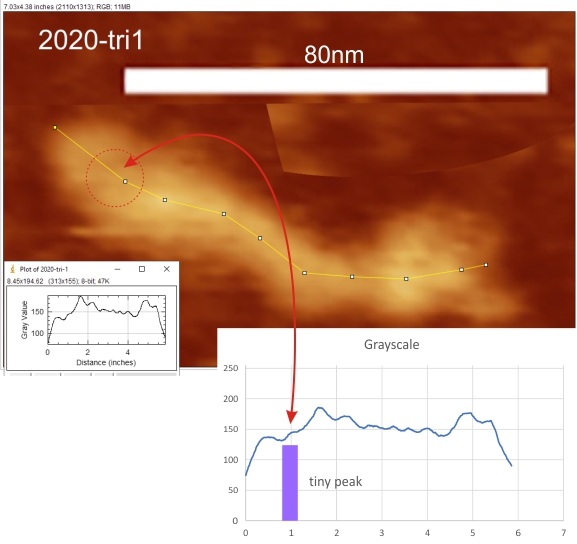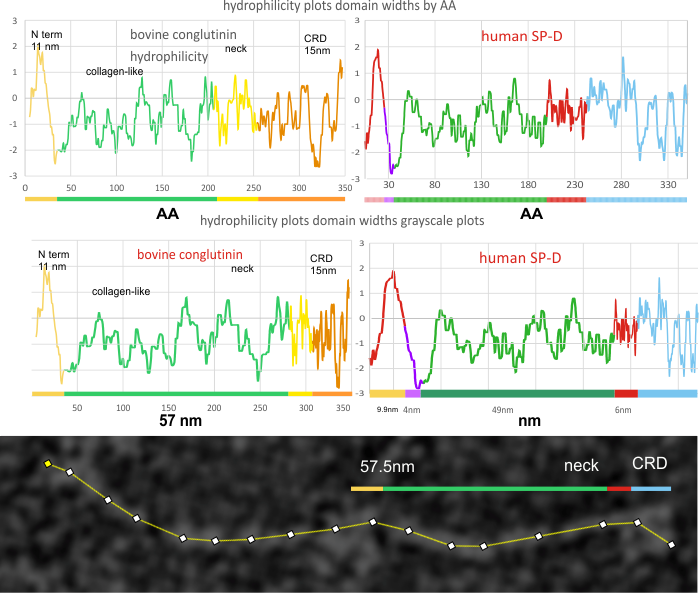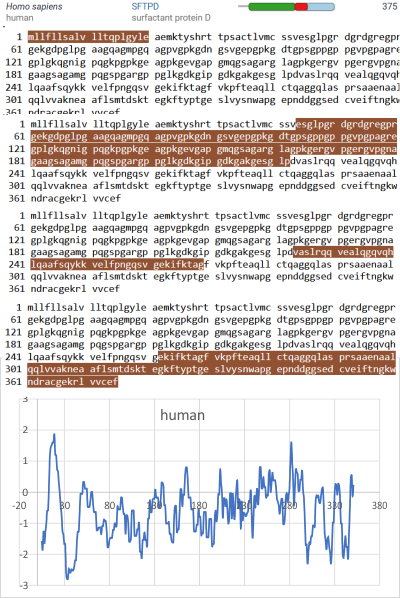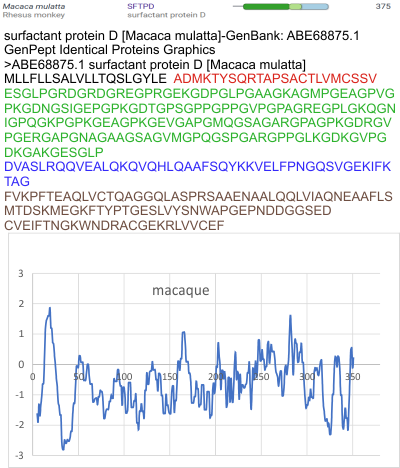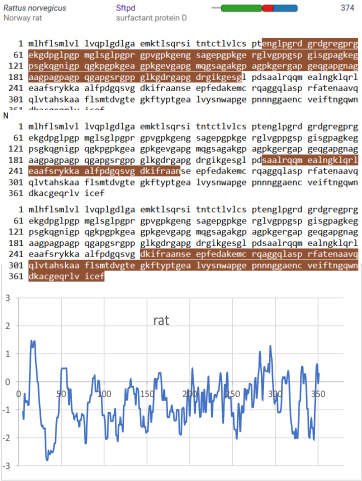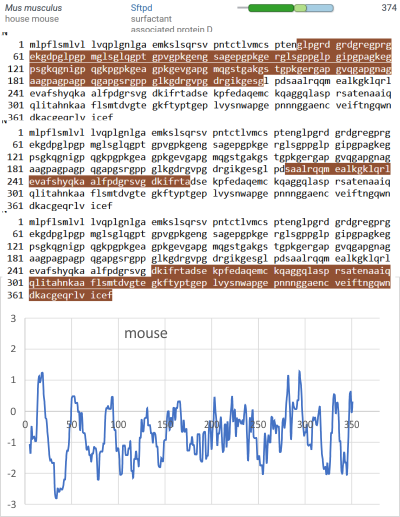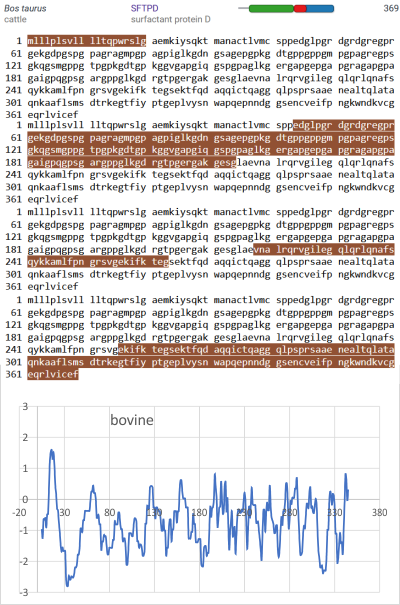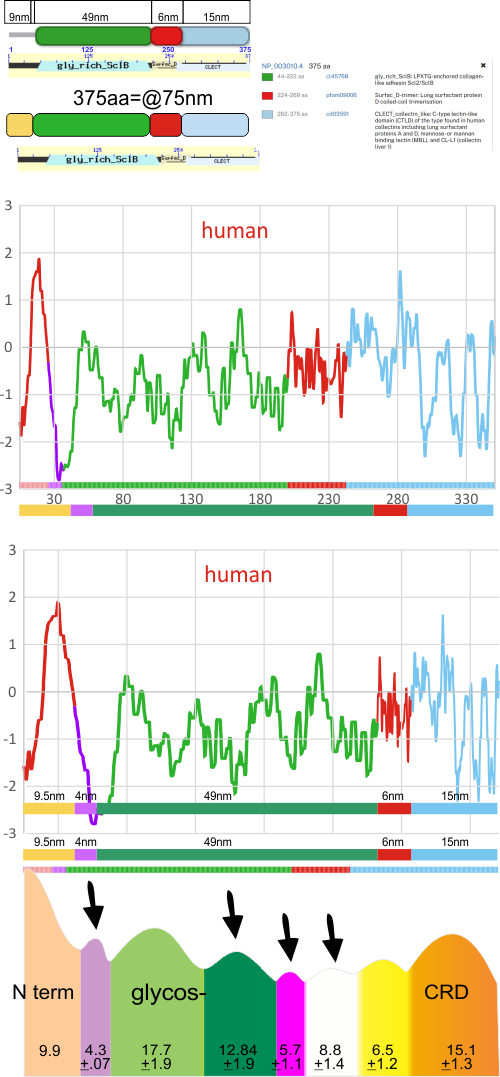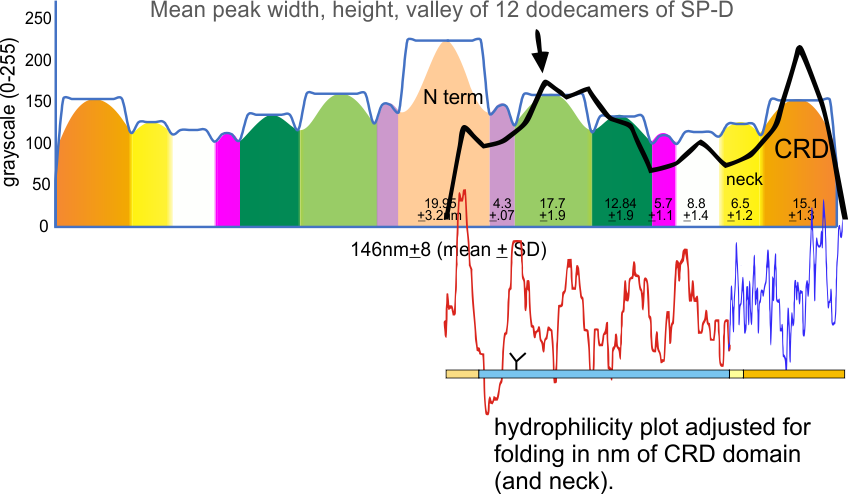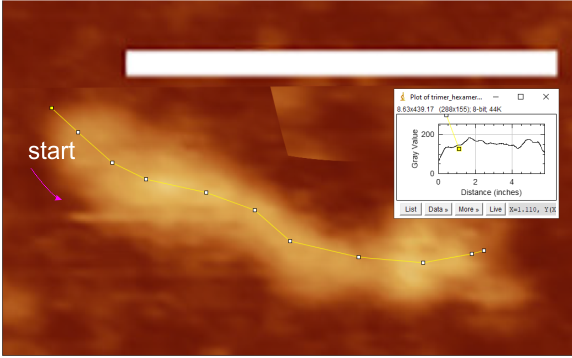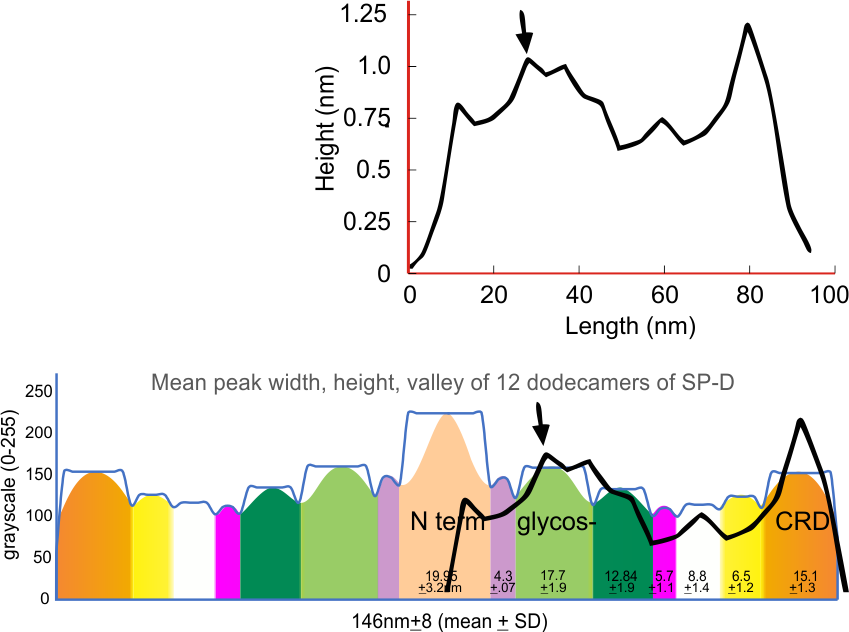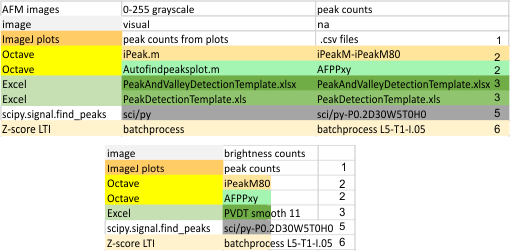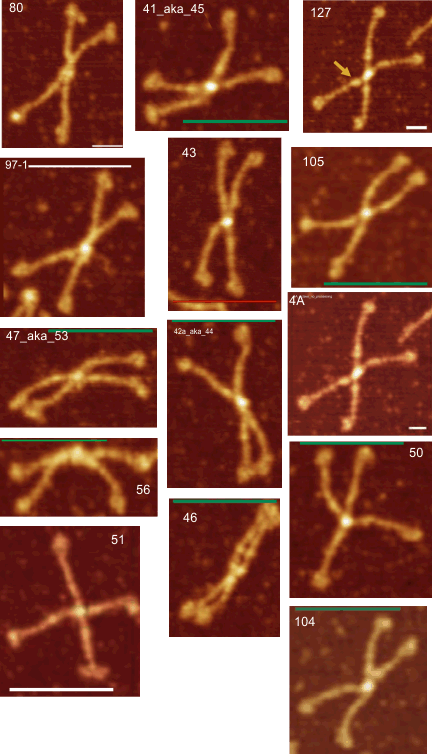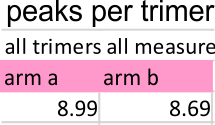SP-D’s “tiny peak” on the downslope of the N term peak is more pronounced when measured on grayscale value in this trimer, and is very low on the valley when four trimers are joined in a dodecamer. Arroyo et al, 2020, Fig 2A right image, bar=80nm for the trimer shown below. Purple bar is just below the peak plotted for this trimer using ImageJ.
Category Archives: surfactant proteins A and D
SP-D and bovine conglutinin hydrophilicity plots by AA and by domain-nm
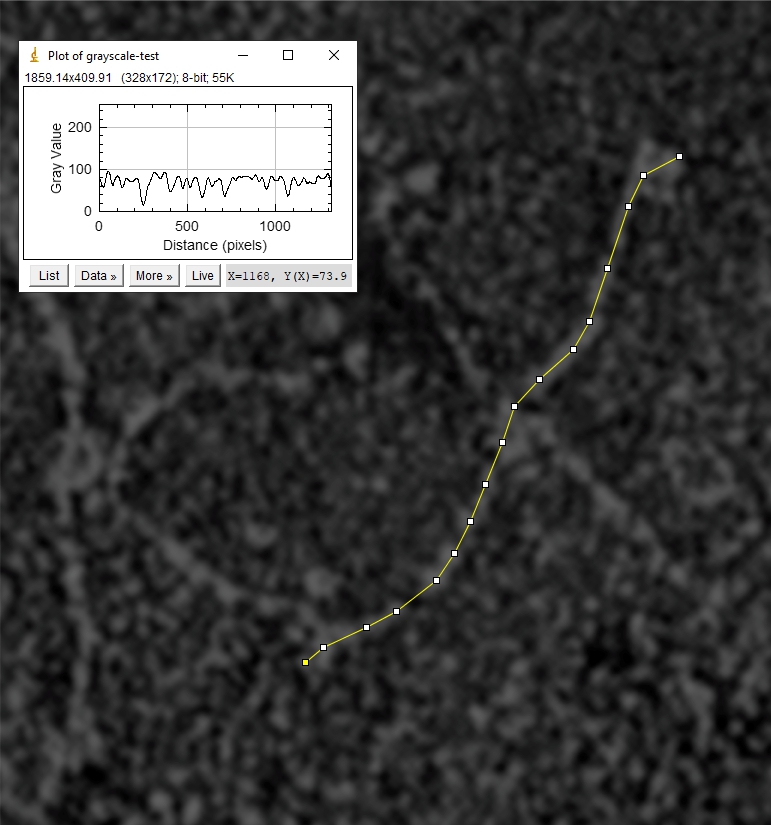 SP-D and bovine conglutinin hydrophilicity plots by AA and by nm. Published images of bovine conglutinin (Strang et al, ) were subjected to gaussian blur then used to plot where the N and the CRD domains were found. His measurements didn’t include the neck regions and it seemed pretty clear that there was such a peak visible in his images.
SP-D and bovine conglutinin hydrophilicity plots by AA and by nm. Published images of bovine conglutinin (Strang et al, ) were subjected to gaussian blur then used to plot where the N and the CRD domains were found. His measurements didn’t include the neck regions and it seemed pretty clear that there was such a peak visible in his images.
Human SP-D hydrophilicity plots (made with the same app by NovoPro where hydrophobic AA are causing the “peaks themselves so better named a hydrophobicity plot), and bovine coglutinin were compared both by the AA sequence and nm dimensions. Strangs images of negatively stained molecules he considered slightly less in length than shadowed images, he did not have AFM images and the my plot comparison is with SP-D is AFM.
Hydrophilicity plot of conglutinin show a different number of peaks along the collagen-like domain…. but still the plot maintains a great similarity to the SP-D. A previous post (here) does plot bovine SP-D in comparison to human SP-D, as well as three other species. These plots are by AA, and I will adjust them to nm plots next. Image below is a crop of the image above and rotated to horizontal. The nm bar does not exist on Strangs images therefore I have estimated this from his description.
Purpose: to determine whether the hydrophilicity plots have been, will be helpful in discerning structure and function of surfactant protein D. Looks like conglutin matches up pretty much. So I am inclined to give them nm values that are predicted by SP-D.
It is possible that a larger CRD region is actually present (as i would have predicted from Strangs image, however i used his dimensions to create the color version above, and the hydrophilicity-by-nm plot just above that.
One interesting point is that Strang mentions different dimensions when using different TEM techniques — and it seems from his imags and comparisons with the CRD region in AFM images that the AFM blends the three CRD regions into a bigger “glob” than the negative staining and shadowing. This may be the reason that the CRD in is smaller than found in the SP-D AFM images. The way to find out of course is to have the each molecule treated in the exact same way.
Just another note, it looks like the N term junction of the shadowed image might actually show structure not seen routinely in AFM images.
Purpose here: to see whether the collagen-like domain, which has much similarity to the SP-D collagen like domain, has the regular “peaks” along its length like SP-D.
Hydrophilicity (hydrophobicity) plots of SP-D
Hydrophilicity (hydrophobicity) plots of SP-D of five species (human, macaque, rat, mouse, and bovine) are convincingly similar to each other (as are their sequence comparisons) to confirm that a pattern was present in the hydrophilicity of some areas of the collagen-like domain. This led me to see whether the as yet unpublished 4 additional grayscale peaks in an SP-D trimer (1 distal to the N term peak, three proximal to the collagen-like domain (plotted in a direction with N term peak on the left) were “in line” with the peaks in the hydrophilicity plots. Known grayscale peaks for SP-D are — N term, glycosylation peak, CRD peaks — identified in published AFM images (Arroyo et al, 2018) there are additional peaks consistently found.
Species hydrophilicity plots of SP-D are below (plots are by AA, and not by folding (see tiny green-red-bar for folding) and a comparison of human hydrophilicity plots, and grayscale plots from AFM Images just for human is HERE.
SP-D hydrophilicity plot vs grayscale plots – update
The hydrophilicity plot(s) for SP-D from 5 species (human, macaque, mouse, rat, bovine) were found using NCBI aa sequences (whoe protein and regions) and an app from NovoPro. (The plots for SP-D were so similar I in terms of the values along the collagen-like domain that it seemed unnecessary to do more – find these plots HERE). They are shown below, each with the species name and the number of aa is on the x axis. The peak widths that have been plotted for SP-D in previous posts are shown, as well as the “half” N term width. The number of aa per domain does not correlate with the number of nm for the peaks, particularly for the folded CRD vs the linear collagen-like-doman. In addition, because of the “hinge” like link between the coiled coil neck domain and the CRD domain, the CRD portions of the molecule can lie back covering a lot of (if not all of) the neck domain, resulting in non-detection of the neck peak in over half the plots.
Using the length (in nm) of a trimer determined by many many plots, 73nm is the trimer length that I will use.
This works out really well in my opinion, except for the fact that on SFTPD orthologs – NCBI there is a small string of aa that are not part of N and not part of the collagen-like domain, and it fits nicely with a tiny peak found at the valley of the N term peak just before the glycosylation peak. Graphic below. Top plot by aa only, bottom plot shown adjusted for now many nm the peak actually shows on AFM images. Black arrows point to peaks which consistently appear in grayscale plots, which have not yet really been published. Peaks without arrows have been described.
SP-D hydrophilicity plot vs grayscale plots
An original hydrophilicity plot (C-J-Guo et al, PLoS Biol. 2008 Nov; 6(11): e266, their Fig. 1 ) shown here 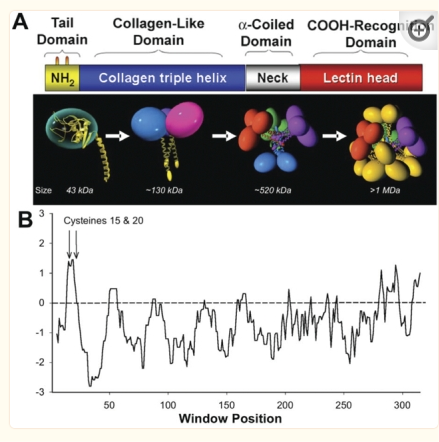 startled me with its similarity to the grayscale plots that seem to be pretty well established for trimers (and the trimer portion of hexamers and dodecamers) of SP-D. The plot seemed to me to be divided into into three distinct peak patterns, one where the N term domain is located (in this case on the right as a very tall peak), a stretch of four large peaks regularly spaced with deep valleys (the collagen-like-domain and with the glycosylation site — the first peak to the right of the N term peak — which they did not identify), and then a dozen irregular low peaks in a stretch reaching the large irregular area where the CRD domain is. In the legend by Guo et al, they do mention that the dimensions of their 3D models have been changed (shortened collagen-like-domain) for “esthetic” purposes (which for me is an error in judgement and means looking at that part of the figure allows for confusion).
startled me with its similarity to the grayscale plots that seem to be pretty well established for trimers (and the trimer portion of hexamers and dodecamers) of SP-D. The plot seemed to me to be divided into into three distinct peak patterns, one where the N term domain is located (in this case on the right as a very tall peak), a stretch of four large peaks regularly spaced with deep valleys (the collagen-like-domain and with the glycosylation site — the first peak to the right of the N term peak — which they did not identify), and then a dozen irregular low peaks in a stretch reaching the large irregular area where the CRD domain is. In the legend by Guo et al, they do mention that the dimensions of their 3D models have been changed (shortened collagen-like-domain) for “esthetic” purposes (which for me is an error in judgement and means looking at that part of the figure allows for confusion).
The label above this original figure that names these four domains and shows their approximate length in terms of aa sequence.
One issue with this depiction is that it does not take into consideration the considerable folding that occurs in the CRD domain. This causes the CRD domain part of the hydrophilicity plot to be disproportionately long and the proportion of the straight collagen like domain is disproportionately short. The actual AFM images of SP-D these domains are not that close in nm of length.
But the possibility of hydrophilicity/hydrophobicity (peaks being hydrophobic AA) being important in the peaks that appear in AFM images was sufficiently similar to compare the grayscale plots with the hydrophilicity plot directly. There is only one plot here (meaning there is going to be variation in the plots from various trimers and thus is to be seen as just an n of 1, unlike the plots of AFM images, but like the grayscale plots, a definite pattern is recognizable).
The main problem in comparing the hydrophilicity/hydrophobicity plot and the grayscale plots is that the latter is measured in nm and the former is measured in amino acid residues. This means the folding and twisting of the carbohydrate recognition domain would be much longer relative to the the CRD domain which is very convoluted so the whole molecule in the hydrophilicity plots need to be adjusted for nm in the grayscale plots, thereby making a good match for peaks difficult. ( In the hydrophilicity plot since it is measured in amino acids the CRD domain plot would be disproportionately long because it does NOT show its typical folding, and the collagen-like-domain (which is basically straight) would appear to be relatively short.)
It would be an easy task to just go adjust the hydrophilicity plot which shows hydrophobic AA as peaks, to “my liking”, which is sort of what I did quickly in the image below. It would be more accurate (and a better fit) if I actually stretched and shrunk the hydrophilicity plot by the actual number of amino acids in each domain, then translated that into nm. Have not done this yet, but here is the jist of what I am pretty sure will show up. Y in the thin bar for the x axis legend at the bottom of the figure is the glycosylation site, which does correspond to the green peak (glycosylation peak) in the AFM plots.
N term peak in a plot of a SP-D trimer
First plot of a trimer, for comparing the N term peak height and width in “trimers” vs “dodecamers” shows that the former domain peak to be about 11nm wide where the peak width for an N term in a hexamer is about twice that. When plotting hexamers which are part of a dodecamer all four trimer N terms domains are present, typically as single very large peak but sometimes with a tiny depression at the top of the peak.
to be sure there is no consistent difference in width between the plots of two hexamers of a dodecamer – hexamers alone need to be plotted.
The peak width of hexamers (plotted as part of a dodecamer – which was done here) is close to double what the trimer N term peak is and trimer peak height is about half the peak height of the N term peak plotted in a hexamer or dodecamer. It looks very much like an area 4x (so convenient).
One other thing to examine on trimers is the presence of a more pronounced “tiny peak” which may be more visible relative to a single trimer than four trimer peaks in a dodecamer.
It will take a lot of plotting to confirm this observation (which now is just an N=1), but certainly it was evident on this image. N term is on the left, plot starts on the left, CRD is on the right (typical two peaks where different floppy CRD might fall during preparation, glycosylation peak is close to the left. It is easy to count at least 8 peaks along this unprocessed image. mar marker is from the original (Arroyo et al, 2020) at 80nm.
The original and the processed: SP-D
Figure below shows an original plot of surfactant protein D (Arroyo et al, 2020) presumably made by the program that comes with the Atomic Force Microscope that was used to visualize the protein preparation. Brightness on the y axis, distance on the x.
I used this plot as a “published” documentation of peak count of a trimer of SP-D. While looking at the images in this and other articles by Arroyo et al, I became convinced there were patterns in the brightness (peaks), symmetrical and mirrored, in the hexamers, dodecamers and multimers (though determining patterns of brightness peaks in the latter is more problematic than in the hexamers and dodecamers).
My own counts of peak number, and peak width were consistent enough that I sought out ways to verify the number and properties of these peaks in an “unbiased” way. (Of course there is no way to be totally unbiased in any research, but I did try to select image filters and signal processing functions that seemed appropriate, easy to use, and produced consistent data which I then applied in the same manner to 12 dodecamers of SP-D).
After more than 1000 plots of Sp-D hexamers, this figure (above) shows that not only are the three peaks defined by Arroyo et al, correct, but the tiniest variations in her plot that would not have been considered significant or relevant are actually verified as actual peaks (see the summary plot with which her plot is compared). This seems to me to reveal several things.
The reason that the N term peak is so large in the dodecamer compared to what Arroyo et al measured in their trimer is that there are four N terminals in a single (maybe not always single, perhaps sometimes side by side) peak that form the common intersection. All other measured peaks are a domains of a single trimer.
1. There is more to be learned about molecular structure from AFM images than is generally perceived, but this requires different types of image and signal processing.
2. There are many programs useful for defining or confirming peak number, width, height, and valley in plots generated by ImageJ that are free and easy to use and include signal as well as image processing apps (and both).
3. ImageJ has a great free plotting app for plotting grayscale values which is easily exported to excel and can be saved as metafiles and manipulated in draw programs such as CorelDRAW.
4. Resulting data here provides details which will assist those who are working to “finish” constructing the molecular model of human surfactant protein D.
Bias: the good, the bad, the learned – peak finding functions and image filtering
Purpose: To contribute to predictions about the current structural model of surfactant protein D, in particular, the collagen-like domain.
Aim: To suggest there are recognizable patterns in the number and shape of peaks in grayscale plots of SP-D obtained when traced from CRD to CRD as a hexamer that can inform molecular models. These grayscale plots of recombinant human surfactant protein D (SP-D) were made with ImageJ from published AFM (atomic force microscope) images (Arroyo et al, 2018) of each of the two hexamers which comprise one dodceamer. Images were ploted as unfiltered images, and as images subjected to a variety of image processing filters and/or signal procesing peak finding functions.
Introduction: A single molecule of SP-D has four domains: N terminal domain, collagen-like domain, coiled coil neck domain, and a carbohydrate recognition domain (CRD). Monomers of SP-D are coiled homotrimers which readily form multimers joined at a communal peak at N terminal domains. N terminal junction peak height and width appears to be a function of how many trimers are bound as a multimer. Hexamers and dodecamers are common multimeric forms, though multimers be found with 30+ trimeric arms (Arroyo et al, 2018).
RCSB ( ) (as of this writing) has many molecular models for the CRD and neck domains of SP-D, but none of the full trimer (all four domains) (nor for hexamers, dodecamers or other multimers( ). Various electron microscopic techniques confirm that the collagen-like domain is reasonably straight or slightly bent, but this information has not yet become part of the molecular model of SP-D.
Arroyo et al (2020) published a grayscale peak count for a trimer at three: 1) N terminal peak, 2) glycosylation peak, and the CRD. Plots of a hexamer would be 5 peaks from CRD to CRD: CRD-glycosylation peak-N-termini junction peak-glycosylation peak-CRD. (Diagram modified from Arroyo et al, 2020 check). Certainly other peaks exist, and 3 was a conservative estimate.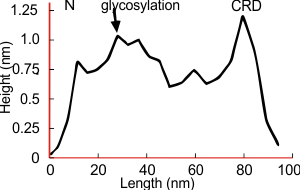
However, a visual count of grayscale peaks from the original 80+ AFM images, and peaks counts obtained from the grayscale plots, with and without image and signal processing functions demonstrated that there are many more than 3 peaks per trimer (5 peaks per hexamer) that are found consistently. Examination of the raw images, images subjected to image filtering, and peak finding functions, showed the peak count for a hexamers was 15. Two additional peaks occur less than 50 percent of the time, not included in the 15, were considered “possible peaks”. The number of peaks per hexamer found without the use of image filters and peak finding functions, was not significantly different than the number of peaks found by just observing the image.
Twelve image processing programs and 4 signal processing programs (each with numerous settings for filtering (e.g. sharpen, median, mode, mean, blur, limit range, noise reduction, etc., and peak detection (smooth, lag, influence, distance, height, threshold, etc.)) were applied to a representative dodecamer selected to determine which image processing and peak finding apps to apply. Considerations included availiability, ease of use, cost, filtering options, output format, consistency with with the visual data from the original images. The resulting number of peaks detected (15) using all results was used as a bench mark.
From those initial plots (n=633) a set of 7 imaging programs and their filters, and 4 peak finding programs and their criteria, were used to assess peaks in 13 additional dodecamers. These data were analyzed individually and together, and demonstrate that 15 peaks are present per hexamer, of which 9 peaks (5 peaks per trimer) were present 95-100% of the time, two peaks per hexamer (1 peak per trimer) were present 71% of the time, while a peak alleged to be at the neck domain was detected 51% of the time. One additional tiny peak was often visible, lying near the valley on the down-slope on either side of the N term junction peak. It was consistent in width, height and location, and was detected 42% of the time (in this discussion it will be referred to as the “tiny peak”.
The linear aspect of the collagen-like-domain, and the presence of 5 easily detected peaks per trimer, along with their peak heights, widths and valleys should provide useful information for predicting the molecularmodel of the collagen-like-domain of SP-D. In addition, the data show that visual identification of peak characteristics and number per trimer (and hexamer) of SP-D was not significantly different from data from images subjected to filters.
Red arrow (figure below) shows the trajectory of a the trimer (beginning at the bottom, CRD, moving upward to the N terminal domain which is linked to three other trimers at the center of the dodecamer.
Methods:
Peak count per hexamer: Peak count was obtained initially, using hundreds of plots, both manual peak counting and counts found using an inclusive number of programs for both image filtering (12 image programs) and signal processing programs (7). Results from all initial peak finding functions from all software initially tested and one dodecamer image (my number 41_aka_45) for a total of 633 plots. These 633 plots were used 1) to define which programs, which filters, which functions produced peak counts most comperable to the peak plots created in ImageJ. This included the lowest counts from a variety of (unbiased?) citizen-scientists, counts including poor resolution (highly pixelated) images, images filters and subjected to peak finding functions. This set of plots determined the number of peaks per hexamer to be 15, a number which was also verified stepwise with 4, 6, 8, 12 and with the final dataset (14 dodecamers and selected functions).
15 peaks per hexamer was used as a baseline for assessing the peaks found by plots analyzed in several different signal processing programs and settings. Both counting peaks by hand, and by function certainly carry some bias. It becomes matter of selection of how to apply parameters in many cases even when visually it appears illogical for the inclusion, or exclusion of some peaks by signal processing functions (see post “to peak or not to peak“. Images were selected as they appeared within original images, every image that was able to be cropped from a figure was saved, thus limiting any selection bias. Number of grayscale peaks in a single hexamer of SP-D was taken at 15 bright (8.1+/2.4 peaks per trimer where the N termini junction is measured as ONE peak whole peak).
Image processing programs and filters: Programs used for the initial peak counts (left column), and the programs used for image filtering listed in the right column (which contains free software, as well as two prominent paid programs). Typically the free-ware provided fewer options for subtle filtering than paid programs. ImageJ was used for plotting grayscale values (peaks) exclusively. T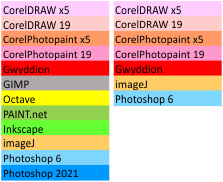 he only other program used for plots was Gwyddion and some discrepancies in tracing grayscale when plots were made in vertical directions as opposed to horizontal, however Gwyddion was used for image filtering. The final choice of software for image filtering is listed on the left.
he only other program used for plots was Gwyddion and some discrepancies in tracing grayscale when plots were made in vertical directions as opposed to horizontal, however Gwyddion was used for image filtering. The final choice of software for image filtering is listed on the left.
Initial signal and image filtering apps are seen in the top portion of this figure, and final choices for all 14 dodecamers lies below.
Further analysis and fine tuning images with gaussian, median, mean, sharpening, and range limiting filters, as well as optimizing peak finding options such as smoothing, distance, height, lag, threshold, width, influence, etc in signal processing shows the peak number to be more than 15 peaks per hexamer.
Line tracings of SP-D to produce grayscale plots: End to end through the center of the hexamer, segmented line, plotted as grayscale in ImageJ. Some details here.
Three peaks per SP-D trimer (5 peaks per hexamer, 9 peaks per dodecamer) have been identified. The tallest peak is central in each hexamer/dodecamer comprising the N terminal junction: 1 N-terminal domain for each of the trimers in the dodecamer. Grayscale plots through the center of a hexamer will have N=4 N terminal domains if it is plotted in a dodecamer. the glycosylation peak(s) (when the SP-D is glycosylated) lie on either side of the N-term peak and the carbohydrate recognition domain (CRD) peak(s), and each of these was recognized by Arroyo et al, (2018). However, their plot (Figure 2, C) 15 peaks can easily be counted, not just the 5 peaks per hexamer that were listed (a very conservative count) in their legend. After extensive analysis, 15 peaks is a reasonable number and, in addition corroborates peaks on their initial plot.
and peak visually from unfiltered images before plots were made (group 1 ) a visual count of bright peaks (arm a in figure 1). Grayscale plots were made (using ImageJ) to determine peak number, height, width and valley of those same unfiltered images by drawing a segmented line lengthwise through individual hexamers (2 per dodecamer) beginning at one CRD through the center width of the N termini junction peak and continuing to the second CRD) (figure 1 yellow plot line, arm b)( a count of peaks from the ImageJ plot.( group 2) . Each of the plots were were then subjected to signal processing functions (group 3) to compare (confirm?) visual assessments (eliminate bias?). LEGEND: Surfactant protein D dodecamer. Two hexamers, with each hexamer of the dodecamer labeled as arm a or arm b. CRD at bottom, center, bright spot (labeled START), moving in the direction of the white arrow to the bright spot at the top of the image (the CRD at the other end of the hexamer). . Red arrow shows the extent of a trimer plot, from CRD (at bottom labeled START, through the entirety of the brightest peak (N termini junction). 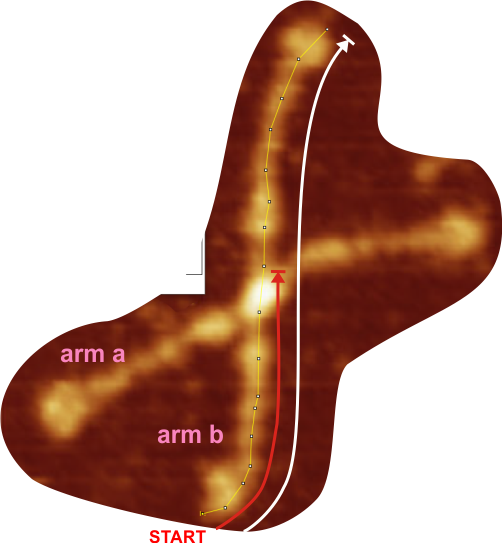
Total number of plots examined for 14 SP-D (figure 2) dodecamers came to over 1500 trimers (that is 385 dodecamers). 14 dodecamers were thus, plotted about 100 times each. (see number for each different dodecamer below. The largest numbers were those several dodecamers that were used to establish the mean number of peaks per hexamer. Clearly dodecamer labelled 41_aka_45 was used to determine which image filtering programs, and which settings for signal processing filters would be used for the other dodecamers. The list also shows the image of each of the 14 dodecamers (labeled in white on AFM images. 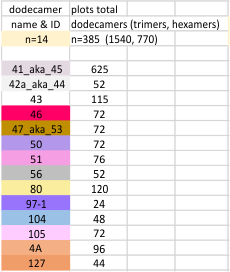
Molecules numbered 127 and 4A are the same but derived from different figures in the same publication. Bar markers in the images varied in the figures from 20,30 to 200nm. Each image was manipulated “along with” its bar marker to insure that dimensions were consistent.
A list of image filters and signal processing functions: (41-aka-45) 292 different image filters plus signal processing functions (trimers so n=73 dodecs) 332 plots, all different image filters in x different image processing programs n=83 dodec)
Image processing programs and filters
Training: the dictionary defines training as “the action of teaching a person or animal a particular skill or type of behavior”. That definition now includes computers and each comes both with great potential, and great limitations.
Learning: the dictionary defines learning as “modification of a behavioral tendency by experience”, and in the case of artificial intelligence, to learn without explicit programming.
Bias: the definition relevant to research is “systematic error introduced into sampling or testing by selecting or encouraging one outcome or answer over others” or “a disproportionate weight in favor of or against an idea or thing”. A rather negative view of bias in research (Zvereva and Kozlov, Sci Rep 11, 226 (2021)DOIhttps://doi.org/10.1038/s41598-020-80677-4), but suggest two important approaches to limit bias – 1) understand the measures available to avoid bias and 2) report measures used to avoid bias. They also state “Cognitive biases are unconscious, which means that simply being aware of the existence and importance of biases is not sufficient to avoid them”.
Machine learning bias: “Machine learning bias, also known as algorithm bias or AI bias, is a phenomenon that occurs when an algorithm produces results that are systemically prejudiced due to erroneous assumptions in the machine learning (supervised and reinforced machine learning) process.”
(it seems like unsupervised, supervised and reinforced machine learning should be great backup for limiting bias in interpretation? – aka mistakes, selection bias? in a relatively simple assessment of peaks in a given plot.
Bias present:
1) non-response bias (missing value): “As a rule of thumb, the lower the response rate, the greater the likelihood of nonresponse bias. Nonresponse bias becomes an issue when the response rate falls below 70%.” (says who)
2) automation bias: “Automation bias is an over-reliance on automated aids and decision support systems”. (method bias)?
3) in-group bias: ” the tendency for us to give preferential emphasis to one group, while ignoring outgroups”.
4) implicit (unconscious) bias: automatic and unintentional, yet impacting outcome (judgement)”.
5) reporting bias: “the decision about what to report depends on the direction or magnitude of the findings”. (thats what peer review is for)
6) false impression bias: “also known as the frequency illusion or recency illusion”
7) sampling bias: “a type of selection bias” –( e.g. test molecules being systematically more likely to be selected in a sample than others).
8) selection bias: “selecting an item (or various items), not using randomization of those items. therefore the data is not representative of the given population”.
9: confirmation bias: “the tendency to search for, interpret, favor, and recall information in a way that confirms or supports one’s prior views”
10) measurement (data collection) bias (errors): ” refers to the tendency of algorithms to reflect human biases (supervised and reinforced machine learning), (personal communication : “you chooses the settings” which is true for python-scipy peak finder (prominence 0.2, distance 30, width 5, threshold 0 height 0); for PHP Zscore (Lag 5, Threshold 1, Influence 0.05), for Octave’s AutoFindPeaksPlot.m (xy), ipeaks.m (M80), and also in PeakValleyDetection.xlsx (smooth 11)).
Bias relevant to outcome,
Selection Bias (yes, just dodecamers, from one researcher)
Spectrum Bias
Cognitive Bias
Data-Snooping Bias
Omitted-Variable Bias (missing data)
Exclusion Bias (out of focus molecules)
Analytical Bias
Reporting Bias (this would appear to be an ethical issue)
The definition of all of the above words has changed: in society, in science, in philosophy.
In the context of this post, the To create an “unbiased” count of the number of peaks
“people should assume right now that the models only perform to about 95% of human accuracy.” (https://mitsloan.mit.edu/ideas-made-to-matter/machine-learning-explained).
Results and Discussion:
Peaks, subpeaks. Figure below shows the analysis at four different tiers in analysing the number of peaks and subpeaks in dodecamers: as an N= 6, 8, 12 and 14 individual molecules, each processed in many ways, and each included in subsequent analyses.
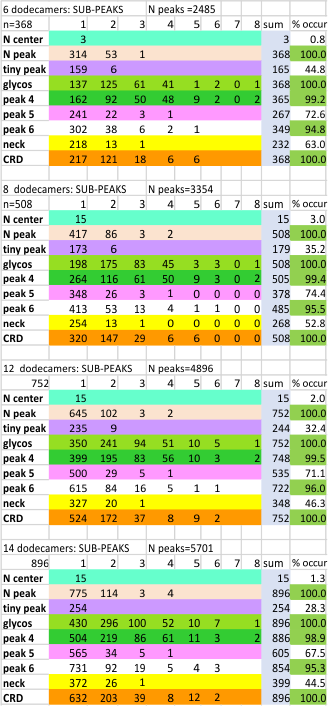 Peak number per trimer is shown in graphic below of an analysis of 14 trimers shows there is no statistically significant difference (none was expected either since SP-D should appear as a bilaterally symmetrical molecule ) between the number of peaks in either of the hexamer’s arms (a and b, i.e. left and right sides of a hexamer, respectively) and therefore, of any trimer in a dodecamer.
Peak number per trimer is shown in graphic below of an analysis of 14 trimers shows there is no statistically significant difference (none was expected either since SP-D should appear as a bilaterally symmetrical molecule ) between the number of peaks in either of the hexamer’s arms (a and b, i.e. left and right sides of a hexamer, respectively) and therefore, of any trimer in a dodecamer.
References and links:
1. Arroyo et al, 2018, https://doi.org/10.1016/j.jmb.2018.03.027
https://imagej.nih.gov/ij/
https://terpconnect.umd.edu/~toh/spectrum/PeakFindingandMeasurement.htm#ipeak
https://terpconnect.umd.edu/~toh/spectrum/PeakFindingandMeasurement.htm#findpeaksx
https://terpconnect.umd.edu/~toh/spectrum/PeakFindingandMeasurement.htm#Spreadsheet (s)
https://docs.scipy.org/doc/scipy/reference/generated/scipy.signal.find_peaks.html
https://stackoverflow.com/questions/22583391/peak-signal-detection-in-realtime-timeseries-data/22640362#22640362 (version: 2020-11-08)
Purpose: methods for unbiased peak finding in AFM images of SP-D
Surfactant protein D (SP-D) is necessary for lung surfactant structure, but also a critical for immune protection of the lung and other tissues (doi: 10.3389/fmed.2018.00018). It is a high molecular weight hydrophilic protein found as trimers but also present as multimers of 30 or more trimers, but dodecamers are the multimer analyzed in this study, suggested to be important for innate immune defense.
The purpose of this study was to find 1) appropriate unbiased methods to determine how many peaks (grayscale) appeared along a segmented centered line drawn from CRD to CRD in a hexamer of SP-D in order to 2) help define the molecular structure of the SP-D hexamer and dodecamer, 2) to identify which peak (brightness, grayscale 0-255) along that trace might be important for binding with….. 3)and to begin a discussion on whether signal processing peak finding functions are helpful in unbiased assessment of topical variation in AFM images while identifying peaks along a plot of any molecule, and SP-D in particular.
Abbreviations: SP-D, surfactant protein D; N-term, N terminal domain and collective junction in the center of the radially organized multimers of SP-D; GLY, glycosylation site of the SP-D trimer; CRD, carbohydrate recognition domain; C-d, collaen-like domain; NECK, coiled coil domain; AFM, atomic force microscopy;
Inspiration for finding out what SP-D dodecamers really “look” like came from the vast array of diagrams of SP-D in the literature which compared to actual microscopic images. Some of these diagrams were just erroneous, and when querried, one author excused his diagram as “artistic license”. There is no room for artistic license in factual representation of data. In addition, others use misguidedly use images in their publications showing just two of the four domains of SP-D without expressly mentioning that this is NOT the entire molecule, but just the coiled coil neck and carbohydrate recognition domains. This matters because consensus suggests there are 4 domains in a monomer of SP-D: a short N terminal domain, a long collagen-like-domain, coiled coil neck domain, and a C-type lectin domain (carbohydrate recognition domain)(CRD), configured as homotrimers with the neck domain thought to be responsible for the coiling of the CRD and collagen-like-domains into trimers. (Ping Li, 2009);doi:10.1074/jbc.m600651200;DOI: 10.1016/j.molimm.2009.06.005). Neck and CRD domains have been modeled often, and flexibility between neck and CRD has been suggested, and is clearly visible in AFM images.
The collagen-like-domain of SP-D is not required for multimer assembly, nor for some of the innate immune functions related viral pathogens has not yet been modeled ( ). It was noted by Kingma et al that it is, however, required for some aspects of macrophage activation and surfactant function (doi:10.1074/jbc.m600651200). Others have investigated edited molecules and examined function, these images are shadowed TEMs, and are not suited as well for peak counting as AFM images (refs).
A realistic diagram of SP-D should easily be possible since hundreds of actual images of the molecule are in the literature, and a large assortment exists of SP-D trimers, hexamers and multmers. The latter are mirrored, symmetrical structures with attachments at the N terminal domains (center) and CRD domains (ends). Negative staining, rotary shadowing and atomic force microscopy confirm that arrangement , and have provided evidence that dodecamers are a “common” form (PMID: 36330647 DOI: 10.2174/1389203724666221102111145;doi:10.1074/jbc.271.31.18912). The proportions of various oligomers differs with methods of preparation, disease, and species.
Negatively stained molecules were less than informative, shadowed images, even wonderfully shadowed images had a background that was almost too textured to make out tiny detail. AFM in particular, in a really wonderful presentation of SP-D images (Arroyo et al, 2018) was method that showed quite a bit of detail. In the latter publication, three peaks along the SP-D trimer were described: the N terminal domain peak, a glycosylation peak (present if the molecule was glycosylated) that occurs somewhere along the collagen-like domain, and the CRD peak at the C term.
Known peaks: The N term peak is a union of 6 N terminal domains and creates the tallest peak of the hexamer (12 in the dodecamer). It consistently has the greatest height and width of all the peaks in multimers. The collagen-like-domain is relatively straight portion of the molecule, but when it is glycosylated, a prominent peak occurs relatively close to the N termini peak, and often has sub-peaks within the overall framework of a single peak. The coiled coil neck region is not only the area with the lowest grayscale values (small peaks) but it is often visibly “covered” due to the floppy nature of the adjacent CRD peaks. The latter peak (CRD peaks) appear as “balls” tethered in a floppy manner to the rest of the molecule at the neck domain region.
It was easy to see in the AFM images of SP-D, that three peaks per trimer (5 per hexamer)(Arroyo et al 2018 doi:10.1016/j.jmb.2018.03.027) was a conservative count, and that other peaks were present in a consistent and mirrorred pattern.
NB, unbiased and biased, these are relative terms. And since the researcher chooses the paramaters of the image filter and signal processing functions, human bias is present. In addition, the specifics of the functions (lag, threshold, height, influence, moving average, smoothing) can be manipulated so extensively that signal processing functions may offer greater opportunity for bias than just counting the peaks from the image, or the grayscale plot of the molecule. Furthermore, biased may not be a bad thing, we learn from practice, watching indices change, from repetition, from seeing in and out of focus images, high and low resolution images, its called “learning”, or “training”, The “learned” bias is present under circumstances which involve both image filtering and signal processing. Peak finding functions do not seem to provide much benefit over a careful, educated visual assessment.
COMMENTS: “filtering out false positives? It sounds like the parameters used to determine what’s signal and what’s noise need to be tweaked to match what you already “know” to be the right count. I don’t know how you’d differentiate between you training the algorithm or you introducing bias, but at the very least you could determine what variable values in the algorithm correspond to what your brain is doing.”
COMMENT: agree, it’s filtering. filtering out noise. i believe there are sliding window methods for filtering or smoothing, but do not recommend arbitrarily creating N bins to put your data into
you could pre-filter or pre-smooth the higher noise frequencies out by some rule- but that should also have some justification. if you filter too much of the high frequncies out you’ll get too few peaks. there is going to be some sweet spot for pre-smoothing out noise but minimizing data loss
the noise floor in this data is artifacts from the AFM itself such as scan lines, and compression artifacts (rectangular jpeg artifacts) in the image causing variations in the gray values that are not in the actual molecule.
i would take a look at what assumptions you can safely make about the SPD molecule- what is the minimum size of an atom (amino acid groups, domains) you expect to see in that moleucule, for starters-you could assume there shouldn’t be any frequencies in your noise below 2x the size of the smallest atom (amino acid groups, domains) in the SPD molecule, for example, and maybe based on the molecules as well, if you explore how the AFM probe detects electric fields. there are assumptions you could make about the noise frequencies.
the noise floor is relatively high, but if you’re certain you can see something, then hopefully you can apply some consistent pre-filters to produce the desired outcome
if you filter the noise down iteratively until you get the most consistent peak *positions* then you should be able to optimize it without going too far and filtering out real peaks (yes i have tried this…. there is a way to eliminate peaks altogether, but also a broad area where peak number doesnt change that much, and then on to unrealistic peak numbers. There is that “sweet spot”.
however the idea that there are always going to be N peaks, or that the molecule is always going to be bilaterally symmetrical may simply be wrong. i would just go where the data leads you and stay open to that- you may discover something unexpected by remaining unbiased. if you’re convinced that your methods are producing the wrong result, then go back and change them
i would definitely leave out anything subjective like your visual acuity.
COMMENT: interestingly in almost 1000 plots, some my counts, some scipy, some octave, some LTI, some excel template — the was no significant difference in the number of peaks i counted from the image, and the number of peaks counted in that batch of algorighms. THere was a difference in how i counted the peaks from the plots, and the number of peaks counted the algorighms.
Little changes in peak counts in the sweet spot “scipy-find_peaks_p0_d30_w5_t-null_h-null”
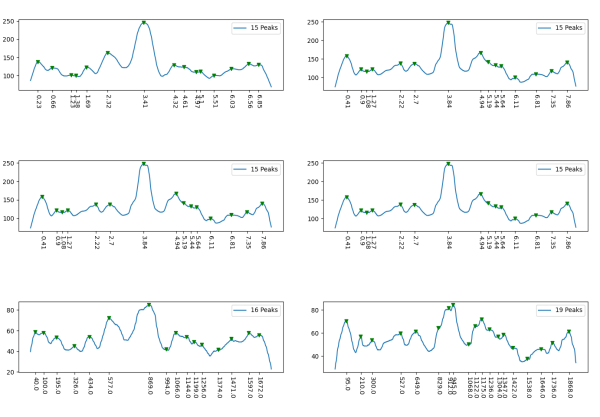
scipy-find_peaks_p0.7_d30_w10_t-null_h-null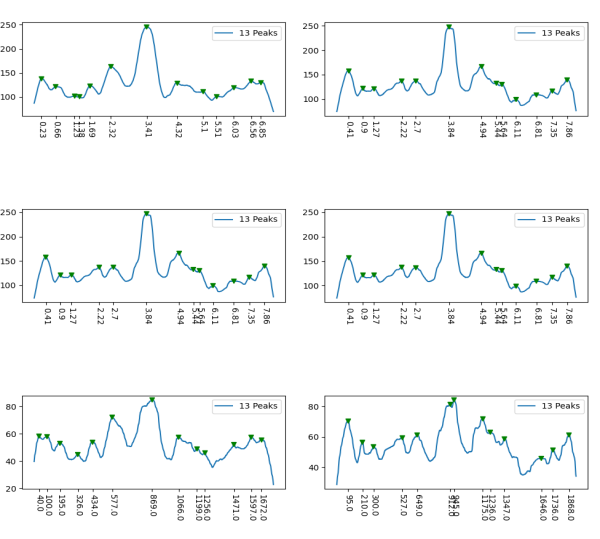
14 dodecamers of SP-D: peak count per trimer
The result from the data of peak numbers, per trimer (two trimers per hexamer (which i labeled a and b), and using all image filters and signal processing peak finding apps for 448 trimers each, for arm a and arm b, there was NO significant difference in number of peaks found one from one side (a) to the other side (b). The t-value is 1.2919, the p-value is .196725 at p < .05.
I used the socscistatistics.com website’s 2-tailed t-test calculator (see graphic below). So just over 8 peaks per trimer (please note that the N term is counted as one whole peak, not divided into “half” as might be expected due to the shared peak of arm a and arm b in each hexamer (or multimer with many trimers). [ALL trimers, ALL measures] image below shows average number of peaks. Arm a is “always” on the left side of the image, and arm b is “always” on the right side of the image. Arm a is also the highest trimer on the left, and arm b is the lower trimer on the image (see diagram at bottom).
The dodecamers expectedly fall randomly on the mica surface during preparation and are scanned in a fixed manner by the probe, and assumed to represent unbased events. The lines measuring grayscale in each molecule are drawn the length of each hexamer (CRD to CRD) through the center-width, and can be at any angle from left to right, as well as curve, or bend. This is assumed to be random. A segmented line was used in ImageJ to accommodate this variability.
 I tested whether the same dimensions were recorded when tracing through a hexamer with ImageJ by rotating the image at various angle, but plot measurements were consistent regardless of how the image was oriented. That said, I also tested plots in Gwyddion and was not successful at creating an unbiased plots when tracings were vertical or lengthy. ImageJ was reliable and easy to use, so all plots were created with that program.
I tested whether the same dimensions were recorded when tracing through a hexamer with ImageJ by rotating the image at various angle, but plot measurements were consistent regardless of how the image was oriented. That said, I also tested plots in Gwyddion and was not successful at creating an unbiased plots when tracings were vertical or lengthy. ImageJ was reliable and easy to use, so all plots were created with that program.
Example below is a tracing for a hexamer, the direction of the trace, start-point, and portion of the trace ascribed to the trimer, and hexamer are highlighted. Light line with nodes show the original trace in ImageJ, white arrow shows direction and inclusion area for a hexamer trace (CRD to CRD) and the red line shows the area included in the calculation of peaks per trimer (which is different than peaks per hexamer, since in that case the N term peak is only counted once per hexamer).
